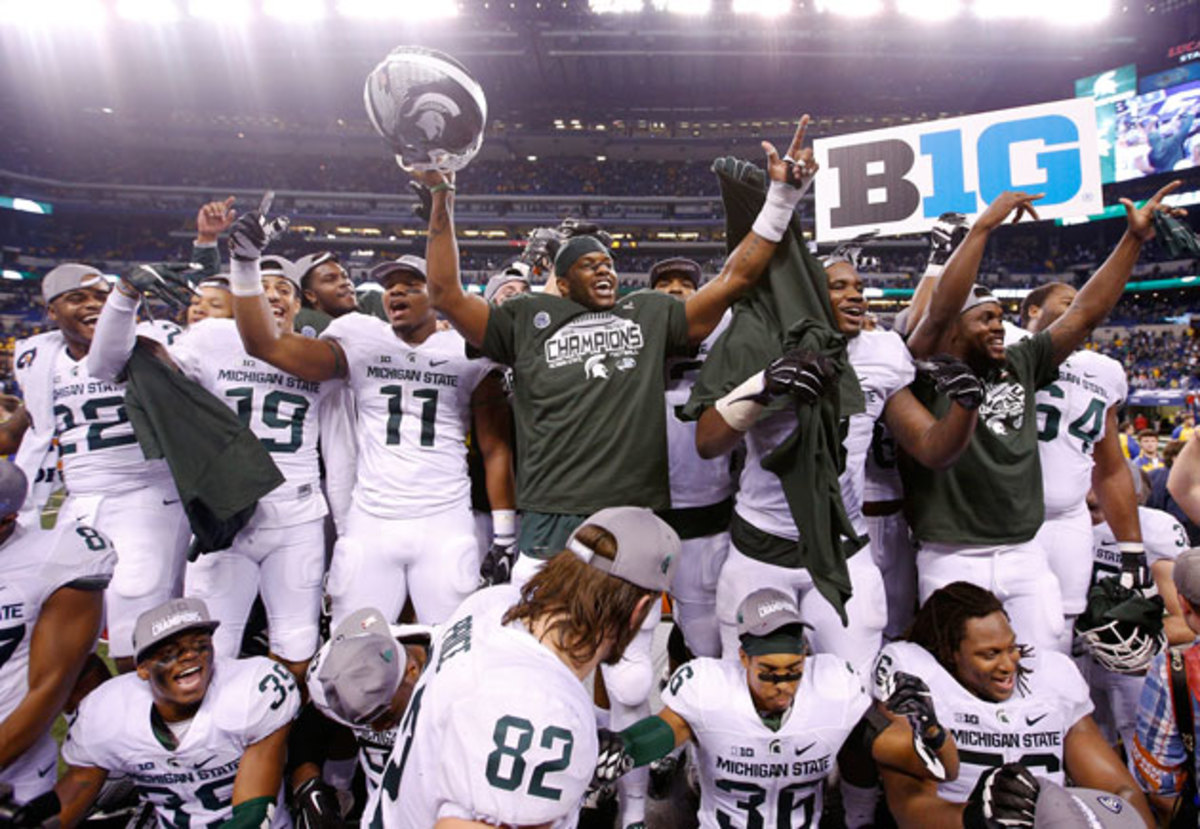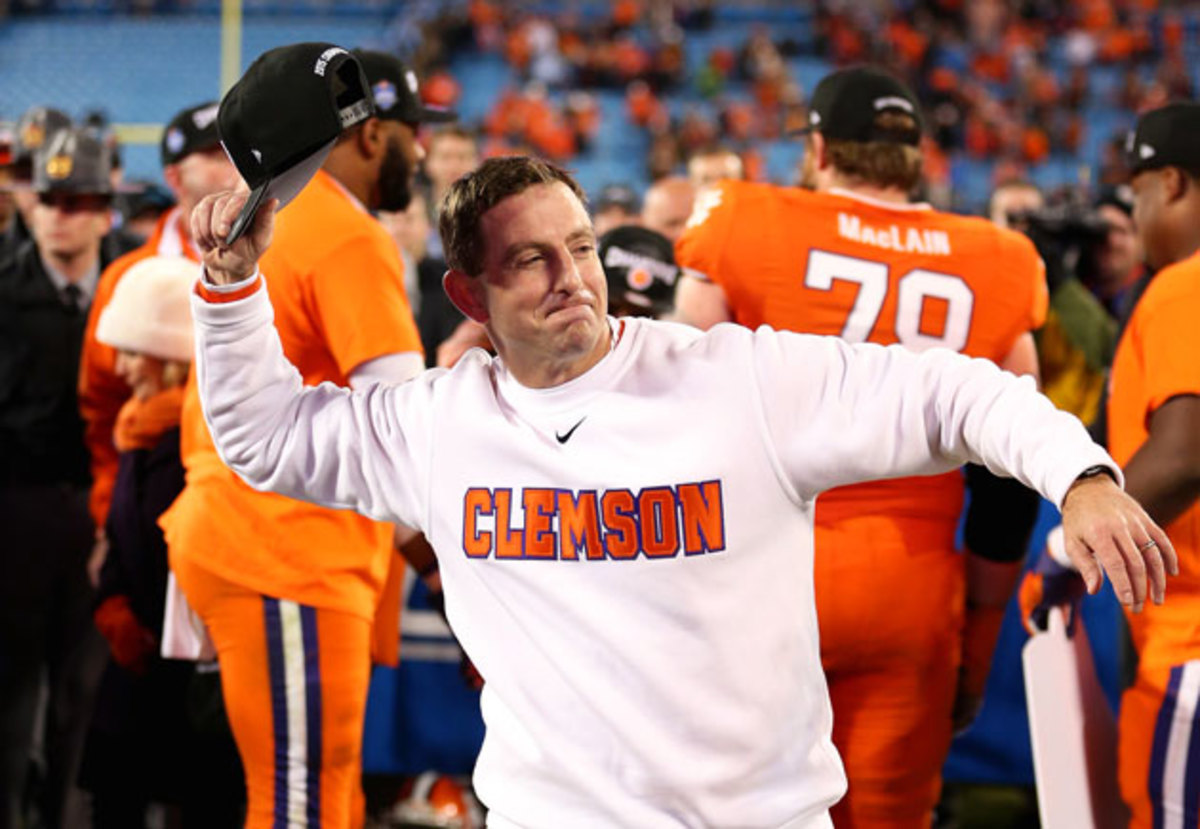College Football Playoff: Sizing up this season's field and semifinal matchups

With Clemson, Alabama and Michigan State taking care of business Saturday while Oklahoma rested, there was little drama surrounding which four teams would make this season’s College Football Playoff. The only uncertainty was over the matchups. The selection committee revealed its choices on Sunday afternoon, placing No. 1 Clemson against No. 4 Oklahoma in the Orange Bowl and No. 2 Alabama against No. 3 Michigan State in the Cotton Bowl.
Here are three thoughts on this year’s playoff field.
1. The theme of this year’s playoff semifinals is revenge
Reaching the national title game is the top prize for the playoff semifinals, but this year’s matchups feature a little extra at stake in both games. For Oklahoma and Alabama, these semifinal matchups are opportunities for vengeance.
Clemson and Oklahoma met in last year’s Russell Athletic Bowl, a game the Sooners have likely tried to forget but may now use as fuel. The Tigers trounced Oklahoma 40–6 behind a dominant outing from quarterback Cole Stoudt and the Clemson defense. Stoudt picked apart the Sooners’ secondary for 319 passing yards with three touchdowns, while the Tigers forced five turnovers.
• ELLIS: Clemson downs North Carolina, shows why it is ranked No. 1
It was a dreary ending to a disappointing season for Oklahoma, though ironically it may have played a part in why the Sooners have risen to where they are. Standout linebacker Eric Striker announced after blowout that he would return to Norman because, “I don’t want to go out like this.” So far, Striker has helped create a much more fitting send-off. Oklahoma lost five games last year, and the Sooners have since beaten four of those teams this season. The only one left is Clemson.
Alabama’s quest for revenge will have to take a slight detour from Columbus to East Lansing, but Nick Saban’s squad can still get back at the conference that knocked it out of last year’s playoff. Cardale Jones, Ezekiel Elliott and Ohio State stunned the Crimson Tide 42–35 in last season’s Sugar Bowl semifinal en route to a national title. That set off a yearlong rise for the Big Ten, which even SEC stalwart Paul Finebaum admitted Sunday was the best league this season.
But program and conference narratives are shaped more than anything by what happens in the postseason. Alabama won’t get the chance to take down Ohio State, but beating the team that beat the Buckeyes would make a pretty strong statement. It’s been three years since an SEC team—Alabama’s 2012 squad—stood atop the college football universe. To get back there, the Crimson Tide will have to knock off the champion of the conference that surpassed them.

2. No matter the reason, it’s good Michigan State jumped Oklahoma
It’s easy to speculate that the playoff committee had ulterior motives to rank the Spartans at No. 3 and the Sooners at No. 4. With Clemson getting the top seed, its semifinal will be the Orange Bowl in Miami. That sent No. 2 Alabama to the Cotton Bowl in Arlington, Texas. Had Oklahoma remained at No. 3, the Sooners would have likely enjoyed home-field advantage even though they were the lower seed.
Crimson Tide fans travel well, so it isn’t as if playing at AT&T Stadium would have resembled Gaylord Family Oklahoma Memorial Stadium South if the Sooners had played Alabama. But it certainly would have been easier for Oklahoma fans to drive 200 miles south to Arlington than for Alabama fans to head 600 miles west.
• HAMILTON: Michigan State's drive for the ages clinches Big Ten title
Of course, it isn’t preposterous to believe Michigan State had a better playoff résumé than Oklahoma. Both teams boast four wins over ranked foes (Oregon, Michigan, Ohio State and Iowa for the Spartans; Tennessee, Baylor, TCU and Oklahoma State for the Sooners), but based on last week’s playoff rankings Michigan State’s collection of wins is over higher ranked teams than Oklahoma’s. The Spartans’ quartet of ranked opponents had an average ranking of 10.25 in last week’s Top 25, compared to the Sooners’ foes, which had an average ranking of 16.25 (and that is before factoring in how far Baylor will drop after losing to Texas Saturday). The teams’ losses (Nebraska for Michigan State; Texas for Oklahoma) were equally baffling, as the Cornhuskers and Longhorns both finished 5–7.
Ultimately, it’s a perfectly defensible decision to place Michigan State ahead of Oklahoma. And the fact that it ensures the top seeds get their justified reward of home-field advantage is an added bonus.

3. The committee was very fortunate with the way things unfolded
In just its second year in existence, the playoff selection committee received a wonderful gift of four clear-cut top teams. Unlike last year, when Baylor and TCU both went 11–1, shared the Big 12 title and were left unhappily outside the top four, the 2015 season made the playoff selections pretty obvious.
Stanford will undoubtedly be frustrated to have won the Pac-12 and not make the playoff, but at 11–2 the Cardinal can hardly allege they were wronged. Ohio State may believe it is one of the four best teams in the nation, but the Buckeyes’ 17–14 loss to Michigan State on Nov. 21, which denied them a berth in the Big Ten title game, left the committee no choice but to exclude them. Even Iowa (12–1) knew its playoff rejection was sealed when Michigan State freshman tailback LJ Scott reached across the goal line for the winning score in the Big Ten championship.
• STAPLES: Alabama shows familiar dominance in rolling past Florida
With only two years of data in the playoff era, the presence of four and only four playoff-worthy teams may seem like a normal occurrence. However, a look back at past seasons reveals how rare it truly is. In fact, one has to go back to 2000 to find another season in which the top four was so clearly decisive. That season similarly produced four power-conference champs with one loss or fewer (12–0 Oklahoma, 10–1 Florida State, 10–1 Miami and 10–1 Washington) with some quality one-loss conference runners-up (10–1 Virginia Tech and 10–1 Oregon State) just behind them. It was the only season in the BCS era to have such a clear top four.
Hopefully chairman Jeff Long and the rest of the committee enjoyed this year. History shows they’re unlikely to have such a simple task again for a long time.
